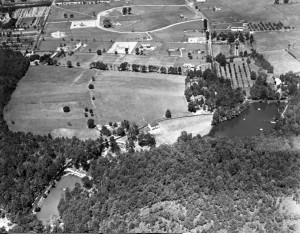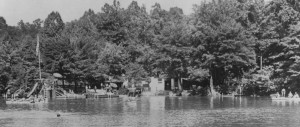
An aerial view from 1929 clearly shows both the Colonial Village (lower left) and Martin’s Dam (upper right) swim clubs, looking north. (Courtesy of the Temple University Urban Archive and the Tredyffrin-Easttown Historical Society)
The history of “Martin’s Dam” dates back to the days of 1848 when that area was known as “Croton Valley.” It is so listed on the Montgomery County Map by Smith and Wister of Philadelphia.
Situated within the “Hundred Mile Woods” and covering the slopes of the foothills near the Chester and Montgomery County boundary lines, for ages past, the waters from two springs have tumbled down over the rocks, joined and formed a never falling creek of considerable force.
Early in the industrial history of Upper Merion, this stream, first known as Croton Creek, later as Crow Creek and finally as Elliot’s Run, named after the innkeeper of King of Prussia Tavern, was dammed at a narrow gap in the hills not far from the source, forming a lake about three acres with a 30-foot head of water available for mill power.
Here, William Martin, who came from England, built his woolen mill and this vicinity became known as “Martin’s Dam,” as it is still called by the oldtimers.

This early view of Martin’s Dam Club was taken from the intersection of Croton Road and Warner Road. The 40-acre club was organized in 1924, and at that time swimming was done in the actual dam for the old Croton Mill, long since demolished. The “old swimming hole” still remains, however three pools service the membership today. (Courtesy J. Michael Morrison.)
A few hundred yards above Martin’s Dam, the Hughes Family built a a small sawmill, also operated by water power. This mill used the primitive “up and down saw”, manufacturing timber, planks, and shingles from trees felled on the steep slopes of the hills above the tumbling creek.
The hills around Martin’s Dam were formerly covered with a fine stand of Chestnut trees. In 1910 a blight hit the trees and in two seasons, all were almost wiped out.
In 1912, the Lower Merion Water Company owned 20 acres of ground surrounding the Croton Pond.
Some years later, a portion of the property was acquired by J. Howard Mecke Jr. developer of Colonial Village.
In 1929, Mecke converted a part of Martin’s Dam into a swim club and recreational center. The club was talked about throughout the entire United States for its natural beauty and quaint furnishings.
Excerpt from Times Herald article “History of Martin’s Dam Dates Back to Days of 1848” by Ed Dybicz.
